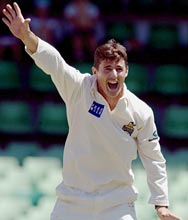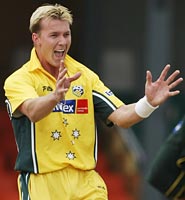Home > Cricket > World Cup 2003 > Columns > Daniel Laidlaw
Australia's pieces come together
January 31, 2003
Leading bowlers Glenn McGrath and Jason Gillespie are yet to return from injuries; Shane Warne has only just come back from a shoulder dislocation; Michael Bevan is fighting to overcome a groin injury, and the all-rounder they have cultivated for nearly 12 months, Shane Watson, is out with stress fractures of the back. For all these injury concerns, Australia's World Cup preparation is in excellent shape.
Physical worries aside, the Australians flew out for South Africa Thursday in the knowledge the pieces needed to win a World Cup are coming into place. Ironically, one the main reasons for that has been the injuries to players who otherwise would have taken part in the tri-series finals wrapped up against England last Saturday.
The ability to adapt to changed circumstances and overcome the loss of key personnel will likely be one of the requirements for World Cup success. For all the planning, preparation and anticipation, the capricious nature of one-day cricket makes flexibility important, performance when required all that counts. For Australia, the 1999 Cup showed that the plans and first eleven with which you start the tournament aren't necessarily those with which you finish it. The Aussies thought Glenn McGrath would be more effective as a first change bowler; that Shane Lee was their best all-rounder. Adjustment in an environment with little room for mistakes is a necessity.
 In this case, the absence of Warne, injuries to McGrath and Gillespie and the loss of Watson has altered the defending champions' Cup picture in a couple of important respects. When Warne went down clutching his shoulder at the MCG on December 15, Australia were forced to induct a replacement spinner, possibly for the entire Cup campaign. The selectors overlooked Stuart MacGill in favour of what they considered to be a more complete package in left-arm wrist spinner Brad Hogg.
In this case, the absence of Warne, injuries to McGrath and Gillespie and the loss of Watson has altered the defending champions' Cup picture in a couple of important respects. When Warne went down clutching his shoulder at the MCG on December 15, Australia were forced to induct a replacement spinner, possibly for the entire Cup campaign. The selectors overlooked Stuart MacGill in favour of what they considered to be a more complete package in left-arm wrist spinner Brad Hogg.
Hogg had a rough beginning, smashed for 75 off 9 wicketless overs by a rampant Jayasuriya and Atapattu, in his second game back after dropping the Sri Lankan captain early on. Fortunately, it got better, as Hogg was to help spark a narrow Australian win over England on January 11 with the wickets of Blackwell, Shah and Collingwood. It wasn't until the next match against Sri Lanka, though, that Hogg appeared to find his feet as one-day international bowler -- noticeably employing his googly more, Hogg deceived Mahela Jayawardene and Russel Arnold in capturing 2/10 off the final five overs of his spell.
A chirpy, smiling personality in the field who moves and throws well, Hogg eventually showed himself to be a useful wicket-taking bowler, a capable back-up to Warne. However, with Hogg's emergence came a dilemma. With Warne's recovery in time for the tri-series finals, Australia faced the prospect of having to sideline a form spinner. Injury to Watson was to obviate that in the short term, as Hogg played the finals alongside Warne as Australia's fifth bowler and the team's all-rounder at No. 7.
At 98/4 in the second final, effectively five down with Bevan's injury, the Aussies needed someone to stand up. Hogg did. In his only genuine batting opportunity of the series, Hogg overcame a nervous start to display composure, confidence, and ultimately a repertoire of shots, scoring 71 not out off 77 balls to ensure his team reached a competitive total.
With the ball, Hogg troubled both Hussain (largely failing to read him) and Vaughan with his turn and bounce, bowling better than his 1/41 indicated. Ian Harvey has replaced Watson in the Cup squad, but he should start the tournament strictly as a back-up. Due to circumstances, Hogg's role has evolved from that of replacement leg-spinner to replacement all-rounder. By showing he can handle himself with the bat, Hogg affords Australia the luxury of playing five bowlers, two of them wrist spinners. With England and Pakistan in their group, this is significant. It is a more formidable line-up with Hogg than it is with Watson. Were it not for injuries, this would not have been discovered.
 Ultimately, Brett Lee also benefited from the absence of others, when he seized the opportunity to lead Australia's attack in the finals. Lee made considerable progress to be named player of the series. While always a wicket-taker, earlier in the series Lee was something of a loose cannon, seeming to suffer from lack of rhythm. Specifically, against England in Hobart, Lee was brought back in the late stages and bowled an inconsistent length that allowed Hussain and Stewart to hit him.
Ultimately, Brett Lee also benefited from the absence of others, when he seized the opportunity to lead Australia's attack in the finals. Lee made considerable progress to be named player of the series. While always a wicket-taker, earlier in the series Lee was something of a loose cannon, seeming to suffer from lack of rhythm. Specifically, against England in Hobart, Lee was brought back in the late stages and bowled an inconsistent length that allowed Hussain and Stewart to hit him.
The first genuine signs of improvement came in Adelaide, when Lee bowled with hostility and accuracy in searing heat for 0/28 from 10 overs. In the finals, he truly came into his own. Given the new ball, Lee established the momentum by bouncing out productive openers Trescothick and Knight early on the way to claiming 3/29 in what was a rout.
The second final was even more impressive, as Lee dismissed both openers cheaply again before returning in the 48th over to be a match-winner. With England needing 14 off 18 balls with 4 wickets in hand, Lee turned the game by bowling Flintoff with his first ball back, having Blackwell caught at gully and yorking Caddick in the last over. Most impressive, though, was the rhythm and accuracy with which he bowled, demonstrating that he could be used at a crucial stage.
Australia will be tested at the World Cup like they haven't been this summer, possibly not since they failed against New Zealand during the '01/02 tri-series. When they are 50/3 in the 12th over of an important game, Martyn, Bevan and Lehmann, or Maher and Symonds, need to show they can inspire as much confidence as the top three.
Assuming McGrath and Gillespie return without any lingering concerns, though, Australia have reason to be optimistic. In Hogg and Lee, they have two pieces of their World Cup puzzle in place.
More Columns
Schedule | Interviews | Columns | Discussion Groups | News | Venues